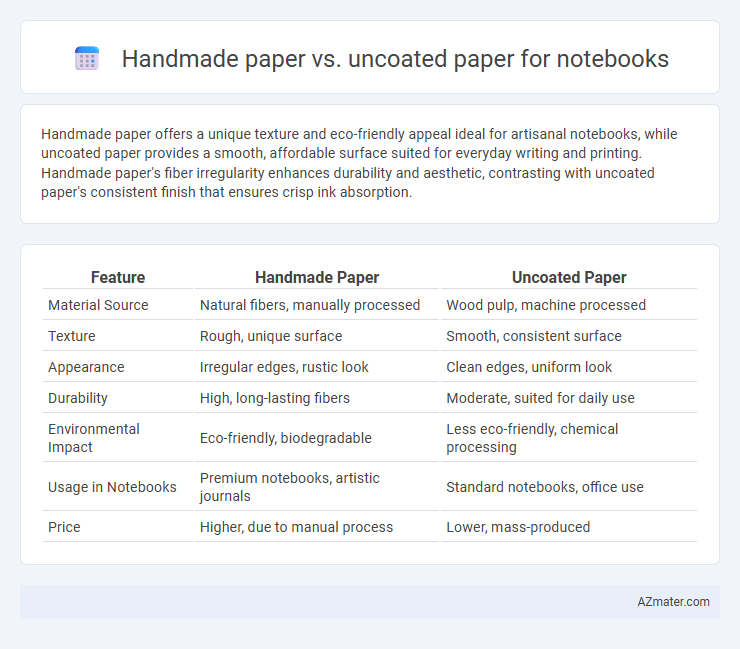Handmade paper offers a unique texture and eco-friendly appeal ideal for artisanal notebooks, while uncoated paper provides a smooth, affordable surface suited for everyday writing and printing. Handmade paper's fiber irregularity enhances durability and aesthetic, contrasting with uncoated paper's consistent finish that ensures crisp ink absorption.
Table of Comparison
| Feature | Handmade Paper | Uncoated Paper |
|---|---|---|
| Material Source | Natural fibers, manually processed | Wood pulp, machine processed |
| Texture | Rough, unique surface | Smooth, consistent surface |
| Appearance | Irregular edges, rustic look | Clean edges, uniform look |
| Durability | High, long-lasting fibers | Moderate, suited for daily use |
| Environmental Impact | Eco-friendly, biodegradable | Less eco-friendly, chemical processing |
| Usage in Notebooks | Premium notebooks, artistic journals | Standard notebooks, office use |
| Price | Higher, due to manual process | Lower, mass-produced |
Understanding Handmade Paper and Uncoated Paper
Handmade paper offers a textured, organic surface created through traditional processes that result in unique fibers and durability ideal for artisanal notebooks. Uncoated paper, lacking a glossy or coated finish, features a natural, matte feel with excellent ink absorption suitable for everyday writing and sketching. Both types emphasize eco-friendliness and tactile quality, but handmade paper typically provides a more distinct aesthetic, while uncoated paper prioritizes functional versatility.
Key Differences in Production Methods
Handmade paper for notebooks is created through a manual process involving pulping, sheet formation, and air drying, resulting in a unique texture and variation in thickness. Uncoated paper, typically produced using industrial machinery, undergoes chemical or mechanical pulping and pressing without applying a surface finish, providing a smooth yet porous surface suitable for writing. The primary production difference lies in the artisanal craftsmanship of handmade paper versus the mechanized, mass-production techniques used for uncoated paper.
Aesthetic Appeal: Texture and Visual Impact
Handmade paper offers a unique, tactile texture with natural fiber variations that create a visually artistic and vintage appearance, enhancing the notebook's aesthetic appeal. Uncoated paper, while smooth and uniform, delivers a clean, matte finish that highlights printed colors and designs with clarity. The choice between the two affects the notebook's visual impact by balancing organic charm against modern simplicity.
Durability and Lifespan Comparison
Handmade paper for notebooks typically offers superior durability due to its thicker fibers and traditional crafting methods, resulting in enhanced resistance to wear, tearing, and aging. Uncoated paper, while often smoother and more affordable, tends to have a shorter lifespan because it is more susceptible to yellowing, moisture damage, and brittleness over time. Choosing handmade paper ensures a longer-lasting notebook that maintains structural integrity and aesthetic appeal even with frequent use.
Writing Experience and Pen Compatibility
Handmade paper offers a unique texture that enhances the tactile writing experience by providing natural resistance and ink absorption, ideal for fountain pens and calligraphy tools without excessive bleed-through. Uncoated paper, often smoother and more uniform, supports a wide range of pen types including ballpoints and gel pens, promoting crisp lines and reduced smudging. Both papers prioritize pen compatibility, but handmade paper is preferred for artistic and expressive writing, whereas uncoated paper suits everyday note-taking and professional settings.
Environmental Impact and Sustainability
Handmade paper is crafted from natural fibers like cotton or recycled materials, resulting in a biodegradable product with minimal chemical processing, which significantly reduces environmental pollution and promotes sustainability. Uncoated paper, typically made from virgin wood pulp, requires more energy and chemicals during production, leading to higher carbon emissions and deforestation concerns. Choosing handmade paper for notebooks supports eco-friendly practices by conserving resources and minimizing waste compared to conventional uncoated paper options.
Customization and Design Flexibility
Handmade paper offers unique texture and organic fiber patterns, making it highly customizable for bespoke notebook designs with an artisanal appeal. Uncoated paper provides a smooth, consistent surface that supports precise printing, allowing for vibrant colors and intricate graphic details. Both options enhance design flexibility, but handmade paper excels in tactile uniqueness while uncoated paper ensures sharp visual customization.
Cost Analysis: Handmade vs Uncoated Paper
Handmade paper typically incurs higher production costs due to labor-intensive processes and limited batch sizes, making it a premium choice for notebooks. In contrast, uncoated paper benefits from efficient mass production, resulting in lower costs suitable for budget-friendly notebook options. The price difference directly impacts the retail cost, with handmade paper notebooks positioned as luxury products and uncoated paper notebooks as economical alternatives.
Ideal Uses for Each Paper Type in Notebooks
Handmade paper's unique texture and durability make it ideal for artistic notebooks, sketchbooks, and journals where tactile experience and aesthetics are prioritized. Uncoated paper, often smoother and more cost-effective, suits everyday use notebooks, planners, and writing pads that require compatibility with various pens and inks. Each paper type supports different writing instruments and user preferences, influencing notebook functionality and design.
Choosing the Right Paper for Your Notebook
Handmade paper offers unique texture and eco-friendly qualities, making it ideal for artistic or personalized notebooks, while uncoated paper provides smoothness and better ink absorption suited for daily writing and printing tasks. Selecting the right paper depends on the notebook's intended use: choose handmade for a tactile, premium feel or uncoated for functionality and clarity. Consider paper weight and durability alongside the writing instrument compatibility to ensure optimal performance and user experience.

Infographic: Handmade paper vs Uncoated paper for Notebook
 azmater.com
azmater.com